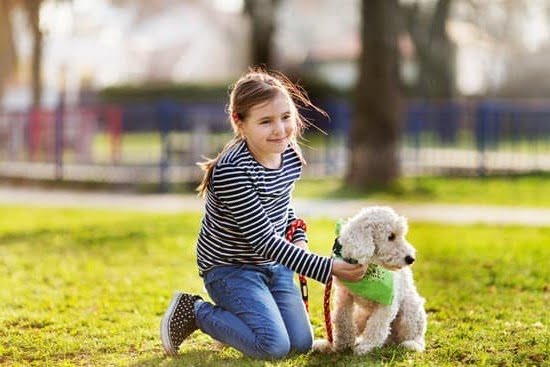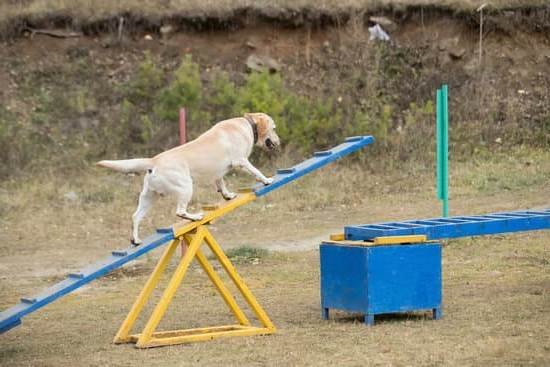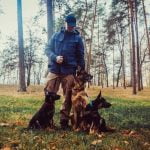Introduction
Training your big dog to get into a camper is beneficial both for you and your pet. Not only will it make traveling as a team easier, it will help ensure that your pup is comfortable and safe during the journey. Before beginning, it’s important to understand the physical and behavioral needs of big dogs in order to provide them with the best possible training experience.
Physically, big dogs need more space than their smaller counterparts due to their size and weight. To accommodate this extra space, you’ll probably need to give your camper some modifications in order for your pup to fit comfortably inside. This could include installing ramps or steps so they can climb easily in and out of the vehicle, as well as strategically placing cushions or pillows on corners or other hard surfaces that might otherwise hurt bigger joints when turning around.
Behaviorally, big dogs respond better to positive reinforcement than negative reinforcement. Taking the time to reward good behavior like getting inside the camper quickly upon being asked will make the process much smoother and faster in the long run. Additionally, introducing any new task slowly is important for ensuring success since learning takes time and patience from both ends! And don’t forget that if things start feeling overwhelming break up the tasks into smaller parts so you can build up to greater achievements.
Overall, having a big dog that knows how to get into a camper without a hassle can be helpful in many ways—from improving safety while out on a road trip to keeping anxiety levels down for everyone involved! Just make sure you keep these physical-behavioral needs in mind when teaching this skill so your pup can learn it effectively and efficiently!
Size Matters
When training a big dog to get into (and out of) a camper, it’s important to select the right one. Remember, dogs are individuals and even large-breed canines will have different needs. For example, some may be tall in stature with long legs that require higher clearance, even for smaller campers. Additionally, consider how much interior space you’ll need for your dog. If the bed is too small or the ceilings are too low, it won’t be comfortable for your pup and could prevent them from enjoying the experience. Always measure critters carefully before committing to a vehicle.
It may also be beneficial to look into camper models that offer extra amenities specifically tailored towards larger animals. Many RV manufacturers now make models with specially reinforced floors and cushioned seating areas made with tough fabrics like leather or kevlar – perfect if your pet regularly hangs out inside with you during road trips. Some also include higher ground clearance options and specialized ramps that can help pets navigate safely up and down steps in a restricted space – perfect if your canine companion often joins you while camping off trail or on uneven surfaces! Double check what extras each company offers before making purchase decisions so you know exactly what kind of features each unit has before committing to spend up..
Gather the Right Training Tools and Methods
When training a big dog to get into a camper, it’s important to have the right tools and approaches to ensure success. To begin with, you will need a quality leash and collar for your dog. It’s best to use one that is made from non-metal so as not to scratch the finish of the camper when your dog enters or exits. Second, you will need treats or rewards that your dog loves in order to motivate them during training. Additionally, it is also helpful to create confidence-building exercises focused on entering and exiting the camper interior with praise and rewards. You may also wish to set up basic commands like sit or stay when entering or exiting the vehicle, which can help build discipline in the long run. Finally, consistency is key—you must stay dedicated and patient when teaching the commands necessary for getting into and out of a camper successfully with both you and your pup!
A Step-by-Step Guide to Introducing Your Dog to the Camper
1. Start by introducing your dog to the camper from a distance. Have someone hold your dog back as you walk around and make them familiar with the camper. Introduce them to the sound and smell of the camper in a calm, soothing manner.
2. Make sure the camper is well prepped for your pup! Place some blankets on the floor (in one of their favourite places), give it a good vacuum, add some treats and a fun toy or two, and maybe even some calming music or a gentle air freshener so they feel more at home.
3. Once you’re confident your pup is comfortable around the camper, it’s time to start introducing them to actually getting inside! Let them explore at their own pace while being closely monitored; reward them with snacks when they respond positively to certain areas or moments in the process.
4. Prepare yourself for mistakes! If anything goes wrong during this process – such as an accident or unexpected noise – remain calm and offer reassurance until they become comfortable again.
5. Let your pup take its time on each step of getting onto the camper itself and into each room, offering treats throughout for positive reinforcement! Patience will be key here and you might have to repeat these steps multiple times until they get used to it completely.
6. As soon as your dog successfully jumps into thecamper on its own, offer abundant praise – this is a big step that deserves recognition! Having made it up into their much bigger domain successfully should provide plenty of motivation for next time!
7. Keep in mind that some dogs may need breaks throughout this process – give them frequent water stops and rest periods when needed so they don’t become overwhelmed or over-tired easily during longer trips out in their new mobile palace! Don’t forget how important mental stimulation is too; hide treats all over where they can find them throughout, or remove distractions if you’re expecting noise or activity close by which makes them anxious or scared.
Positive Reinforcement as a Way to Encourage and Empower Your Dog
Positive reinforcement is an important tool when it comes to training your dog, especially when training them to get into a camper. It is paramount to reward them for appropriate behavior as this will build their confidence and encourage further good performance. You can reward your dog with treats, toys or verbal praise when they demonstrate the desired behaviors. This reinforces what you are trying to teach them and encourages repeat performances of that behavior.
In addition, bodily language is also important in terms of positive reinforcement. Your physical posture can make all the difference in how your pet reads you and responds accordingly. For example, while teaching your big dog how to get into a camper, be sure to stand tall at the entrance with a relaxed facial expression. Move slowly and calmly around your pet as you provide encouragement and praise. This body language communicates ‘I’m not afraid of this task, let’s do this together!’ Your pet will understand these nonverbal cues and hopefully follow suit.
Along with offering rewards, it may be beneficial for you to take the lead (literally!) by gently guiding your dog into the camper whilst providing support from behind until they become comfortable enough on their own. Lastly, never use punishment or negative reinforcement as it could instill fear or anxiety in your pet which won’t help any progress with the training process.
Preparing the Camper With Pet-Safe Items and Features
Before attempting to train your big dog to get into a camper, it is important that you first prepare the camper for them. Pet safety is essential, so make sure to take stock of any items or features that could be hazardous to your pup. Invest in necessary items such as pet beds and pet gates that fit the camper’s layout and size. Consider installing anti-slip mats in high-traffic areas, like steps and stairs, so your pup can walk around without slipping or sliding. Assemble pet feeders and water bowls specifically designed for outdoors activities. Additionally, look into weatherproof material options for extra protection against the elements. Finally, inspect all surfaces where pets will have access to determine whether they are sharp or jagged in any way – if needed, invest in some mild protective corner guards to ensure your pup’s safety inside the camper.
Identifying Ways to Deal With Potential Behavioral Issues
Before training your big dog to get into a camper, it’s important to identify any potential behavioral issues that could arise while doing so. It may be beneficial to consider whether or not the camper is large enough for them to comfortably maneuver around in and if they have a history of agitation when confined in area with unfamiliar smells and surfaces. If your dog has exhibited behaviors such as barking, biting, or dirt-digging in the past, this could pose an issue in training them properly. Additionally, it’s vital to ensure that their energy levels are appropriate for them to stay calm; dogs who are overly excited will struggle when expected to enter tight spaces like campers.
In order to successfully train your big dog, try breaking down the process into manageable steps. Start by getting them comfortable around the camper itself. Move slowly and calmly, bring treats and rewards, and provide plenty of positive reinforcement when they demonstrate good behavior near or inside the camper. Teach them step-by-step the actions you expect from them such as entering the door calmly on command or remaining still in one spot once inside the vehicle. Above all else remain patient – consistency is key in building positive behavior patterns while training your pup.
Setting Up a Comfortable and Safe Environment for Your Dog
The first step to training your big dog to get into a camper is to create a comfortable and safe environment for them. This includes providing the proper bedding that fits their size, as well as having plenty of toys and cozy blankets for them to enjoy. If possible, create an area in the camper that is solely theirs, with items from home such as their chosen blankets and favorite toys. Additionally, you should make sure zoning laws in the area allow for having a pet inside campers before bringing your pup along on any trips. Furthermore, it is important to secure the space by making sure all windows, doors and openings are sealed off tight so they don’t accidentally fall or escape while parked or while in transit. You should also consider getting the appropriate travel products like crates or cargo restraints to ensure your dog remains safely secured when you’re away from the camping site. Finally, make sure that you bring extra food, water, treats and other necessary items like medication on each trip, as well as a first aid kit just in case of emergencies. With these tips in mind, you will create a safe and secure environment for your pup when venturing into the great outdoors with your camper!
Troubleshooting and Overcoming Potential Roadblocks
When training a big dog to get into a camper, it is important to be prepared for any potential roadblocks that may arise. Start by setting up the space inside the camper in a way that will be comfortable and inviting for your big dog. Place his bed, favorite toys, and other items that he likes within easy reach so he knows it’s his safe place. Make sure all the safety precautions are in place and that your pet can easily enter and exit without any problems.
Once you have set up the camper’s interior, begin by introducing your pet to its new environment with lots of praise and treats. Show him around the camper, pointing out where is bed or toys are located. Then provide him with a few treats and verbal commands as you lead him through an entranceway such as over an obstacle or through a doggy door while repeating his commands consistently. This will help to get your pup used to navigating the space of the camper safely.
Once inside, allow your pet time to familiarize himself with his new environment before making it necessary for him to move around much more than what was required during initial introductions. Slowly increase difficulty levels with each training session, leading them up steps or onto furniture if needed. don’t forget rewards–including both verbal praise and tasty treats! If there seem to be any issues along the way with your pup not wanting to cooperate or getting scared about being in a new place, take plenty of breaks so he doesn’t become overwhelmed or anxious being in unfamiliar territory. Stay patient – eventually with diligence on both yours and his part, you’ll be able to work together successfully towards training him how to get inside the camper properly!
Conclusion
Once you have followed all the necessary steps to train your big dog on how to get into the camper, you can now set up the perfect dog-friendly environment for both of you. Your pet will need a comfortable sleeping space, so consider what type and size of dog bed works best. If possible, select a spot that is not directly next to the door or main access points – this will give your pet a bit more privacy. Additionally, make sure to provide plenty of food and water bowls in an accessible zone for easy refills throughout the trip. Finally, be sure to bring along some toys and treats on your camping trips – it may also be beneficial to include appropriate items like chew toys for when your pup needs something else to occupy its time. With all of these considerations in mind, you are now ready for safe and successful camping trips with your canine friend!

Welcome to the blog! I am a professional dog trainer and have been working with dogs for many years. In this blog, I will be discussing various topics related to dog training, including tips, tricks, and advice. I hope you find this information helpful and informative. Thanks for reading!





